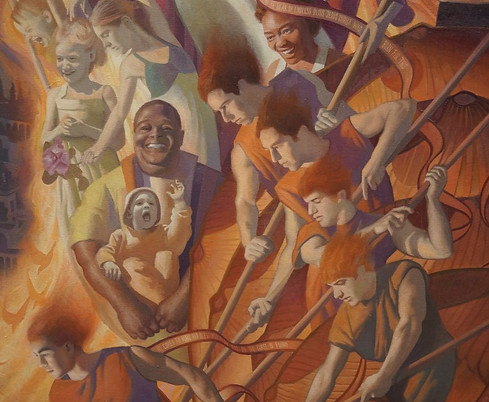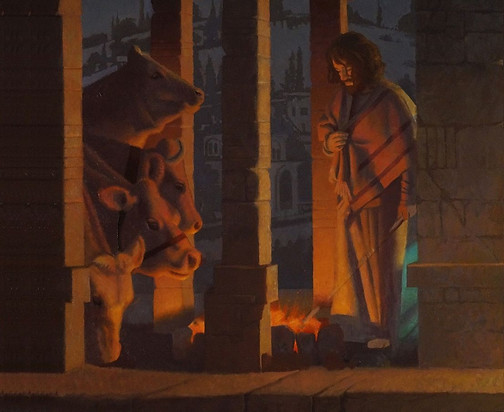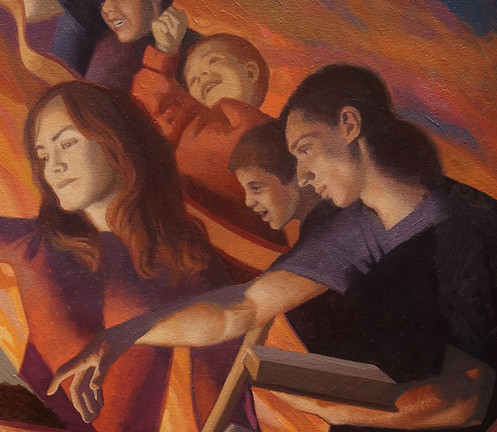L U K E A L L S B R O O K
Explanatory Notes
“Nativity” was inspired by a lecture the artist heard at Redeemer Presbyterian Church in New York City by Dr. Hannibal Silver which interpreted Revelation 12 as a picture of The Birth of Jesus. C. S. Lewis said, “The Christian story is precisely the story of one grand miracle…that what is beyond all space and time, what is uncreated, eternal, came into nature, into human nature, descending into His own universe…” In the painting, the birth of Christ is seen as a supernatural invasion.


Mary and Joseph are pictured in a stable that is constructed from the dilapidated ruins of a Roman building, a reminder that the Kingdom of God will transcend all earthly powers. The timbers form a great cross which leans over the lamb, foreshadowing the crucifixion. Unseen by them, the citizenry of heaven, both people and angels, have broken into our world and are driving Satan and his followers into the darkness. They succeed not by force of arms, but by the good news they bring: Jesus has been born into the world to redeem people by His loving sacrifice. They brandish standards with long scrolls that proclaim this.


The heavenly host is a throng of various and multitudinous figures. Three women clasping hands are the three Graces or Fates from Art and Literature. They represent God’s truth, echoing through all the legends, myths, and dreams of every civilization. The elderly man with the shovel is a depiction of the artist’s grandfather, a symbol of the importance of ancestry and work. The African American man is a depiction of the artist’s friend and colleague who once struggled with addictions and was the victim of abuse. He is pictured now joyful at the center of the throng, surrounded by laughing children.
_JPG.jpg)

The pointing man in black is a symbol of Old Testament prophecy, which looked forward to a savior. The four men with staves represent the four seraphs, traditionally the highest order of angels. The bridal couple at the top of the painting depicts the artist and his wife. They represent romantic love. They also represent the biblical metaphor of the bride and groom as Christ and the Church.

_JPG.jpg)
Juxtaposed to this couple at the very bottom of the painting is another couple which represents the distortion of romantic love. Their faces have become fused together and they are embraced by a spider which feeds on both of them. Other figures around them represent various aspects of evil. The delight of another’s suffering is represented by a clown who holds a monitor with a sick infant on the screen. Heartless and brutal business or bureaucracy is represented by the three baboons in business suits. Self-righteous or legalistic “religion” of any kind is represented by the cleric holding onto a book of rules. In the midst of these is the dragon from Revelation 12 who waits in vain to swallow the newborn child. The dragon has seven heads similar to the “beast” in the Book of Daniel.

_JPG.jpg)
Text carved on the frame:

"The dragon stood in front of the woman who was about to give birth, so that he might devour her child the moment it was born…and there was war in heaven…The great dragon was hurled down- that ancient serpent called the devil, or Satan, who leads the whole world astray. He was hurled to the earth, and his angels with him. Then I heard a loud voice in heaven say...”The accuser of our brothers, who accuses them before our God day and night, has been hurled down. They overcame him by the blood of the Lamb…” -Revelation 12 “Do not be afraid, for behold, I bring you good tidings of great joy which will be to all people. For there is born to you this day in the city of David a Savior, who is Christ the Lord. And this will be the sign to you: You will find a babe wrapped in swaddling clothes, lying in a manger.” -from Luke 2
Process of Creation
The painting began with the idea of picturing the Birth of Christ as a supernatural invasion. I spent many weeks thinking about the concept and composition. This involved reading and meditating on the Biblical texts, journaling and drawing thumbnail sketches. I then built a model of the stable, lighted it, and took pictures.


Then began a long process of finding models, obtaining photo references and producing drawings which served as full scale cartoons to transfer to the canvas.
.jpg)


Finally, I transferred the drawings to the canvas and the actual painting began.



